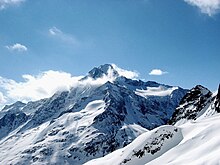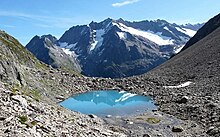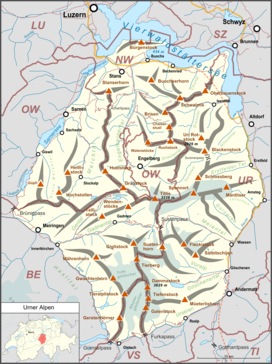Uri Alps
| Uri Alps | |
|---|---|
 The Dammastock from the Göscheneralp | |
| Highest point | |
| Peak | Dammastock |
| Elevation | 3,630 m (11,910 ft) |
| Coordinates | 46°38′28″N 8°25′6″E / 46.64111°N 8.41833°E |
| Naming | |
| Native name | Urner Alpen (German) |
| Geography | |
| Country | Switzerland |
Schwyzer Alps, Glarus Alps and Lepontine Alps | |
| Topo map | Swiss Federal Office of Topography swisstopo |
The Uri Alps (also known as Urner Alps,
The Uri Alps are composed of two distinct groups separated by the Susten Pass. The Dammastock massif on the south is the most glaciated part while the northern part, which culminates on Titlis, has lower summits but greater extent.
Geography
The group south of the Susten Pass forms the dividing range between the head waters of the
On the north side of the Susten Pass the ranges are lower and, except the highest mountains on the south, free of glaciers. The main ridge, culminating at the Titlis divides the basins of the Aare and the Reuss. From the Grassen, tripoint border between the cantons of Bern, Obwalden and Uri, a small range diverges from the main watershed and runs from west to east and culminates at the Gross Spannort.
Principal summits





The principal summits of the Uri Alps are:
- Dammastock, 3630 m
- Schneestock, 3608 m
- Rhonestock, 3588 m
- Galenstock, 3586 m
- Eggstock, 3556 m
- Tiefenstock, 3515 m
- Sustenhorn, 3502 m
- Hinter Tierberg, 3447 m
- Gwächtenhorn, 3420 m
- Mittlerer Tierberg, 3418 m
- Fleckistock, 3416 m
- Maasplanggstock, 3401 m
- Wysse Nollen, 3398 m
- Diechterhorn, 3389 m
- Tieralplistock, 3382 m
- Chli Sustenhorn, 3318 m
- Vorderes Sustenlimihorn, 3316 m
- Stucklistock, 3308 m
- Gletschhorn, 3305 m
- Titlis, 3238 m
- Rorspitzli, 3220 m
- Sidelenhorn, 3217 m
- Gwächtenhorn, 3214 m
- Brunnenstock, 3210 m
- Chüeplanggenstock, 3207 m
- Gross Bielenhorn, 3207 m
- Voralphorn, 3203 m
- Winterstock, 3203 m
- Chelenalphorn, 3202 m
- Gross Griessenhorn, 3202 m
- Gross Spannort, 3198 m
- Hinteres Sustenlimihorn, 3194 m
- Gärstenhörner, 3189 m
- Limistock, 3189 m
- Tällistock, 3185 m
- Rotstock, 3183 m
- Hoch Horefellistock, 3175 m
- Gross Furkahorn, 3169 m
- Winterberg, 3167 m
- Chli Spannort, 3140 m
- Hinter Schloss (Schlossberg), 3132 m
- Steinhüshorn, 3121 m
- Chilchlistock, 3114 m
- Krönten, 3107 m
- Hintere Gelmerhörner, 3100 m
- Vorderer Tierberg, 3091 m
- Zwächten, 3078 m
- Lochberg, 3074 m
- Müeterlishorn, 3066 m
- Wendenstöcke, 3042 m
- Blauberg, 3039 m
- Triftstöckli, 3035 m
- Klein Titlis, 3028 m
- Klein Furkahorn, 3026 m
- Wendenhorn, 3023 m
- Spitzli, 3011 m
- Bächenstock, 3008 m
- Reissend Nollen, 3003 m
- Mittagstock, 2,989 m
- Giglistock, 2900 m
- Engelberger Rotstock, 2818 m
- Radlefshorn, 2603 m
- Hochstollen, 2481 m
- Wandelen, 2105 m
Glaciers
Main glaciers :
- Rhone Glacier
- Trift Glacier
- Stein Glacier
- Tiefen Glacier
- Chelen Glacier
- Damma Glacier
References
- Swisstopo maps

